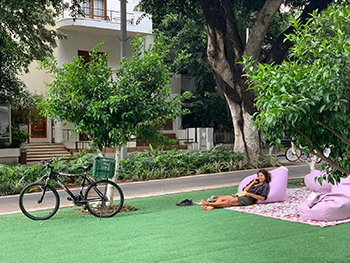Yap loves design, travel and everything beautiful in life. He writes for various media about travel and design and has published works, including Wander Bhutan and Myanmar Odyssey. Formerly publisher of Lonely Planet (China Office), Yap is now Chief Content Officer of Youpu Apps, a Beijing based travel app company.
Sometimes I would wonder which street could represent my lifestyle in the city I reside in.
Streets are bloodstreams of a city. A fun street would definitely leave an unforgettable and wonderful impression on visitors in town. Tel Aviv is a young and humble city. Whenever I think of this most fashionable city in Israel, Rothschild Boulevard will always come to my mind. When I was travelling in Tel Aviv, I was staying near Rothschild, which is a traffic intersection that you will pass by if you are going to attractions such as Yafo or lively beaches on the shore. It was a street that I would always pass by, where I would also stay longer for the fun things that were happening there.
The 2-km long Rothschild Boulevard is the earlier street designed in Tel Aviv, enjoying big fame among the locals. The old houses along the boulevard are also witnesses of the establishment of Israel. In 1948, the Israeli Declaration of Independence was signed here at the Independence Hall.
If you are interested in Bauhaus architecture design, then you would probably want to stay at the Rothschild longer. Between the 1920s and 1930s, Bauhaus architecture started to gain attention in Germany. After Hitler assumed power in 1933, more and more Jewish people started to flee to Israel, who also brought along Bauhaus design to Tel Aviv. Many of the Jewish architects were, in fact, graduates from Bauhaus Dessau. They came to Tel Aviv, a city that was just starting to develop, and turned deserts into their experimental field. In order to help immigrants displaced by the chaos in Europe settle in Israel, it became an urgent need to construct a large number of houses in a very short time. That is why Bauhaus was able to set itself apart from the crowd even though such style appeared to be shabby at that time. Bauhaus was inarguably the optimal solution in a time when resources were limited.
Slim window design can block out the intense sun in Tel Aviv while the balcony and hollow bottom design ensure ventilation. The simple linear and shape design is the assurance that guarantees there will be no waste of construction materials. Bauhaus designs believe in functionality and embed their aesthetics in these seemingly but practical designs. To save construction cost, these plain-looking buildings have almost no additional decoration. But these curvy balconies and symmetric buildings look incredibly classic today. Rothschild Boulevard concentrates the most interesting Bauhaus buildings in town. Many of the buildings are actually under protection and have been converted into boutique hotels, restaurants, etc.

One section of Rothschild Boulevard is home to many of the most expensive headquarters of banks in Tel Aviv, making Rothschild somewhat a financial centre in the city. Surprisingly, this robust economic centre is not overly bustling at all. You can still find plenty of booths that are dedicated to making good coffee. These small cafés are always packed. At Rothschild Boulevard, you can also find many performance spaces as this is the cultural centre of Tel Aviv as well. In the alleys hide a number of the most popular restaurants and cafés in town. Rothschild Boulevard serves different functions in Tel Aviv, attracting a diverse pool of people. This is what makes Rothschild the most classic street in the city.
Rothschild Boulevard started to lose its prosperity from the 1960s to 1980s. The boulevard became dirty and its infrastructure started to deteriorate. However, the boulevard was injected with new blood in 2005. The local government designed a revitalisation scheme to restore historical buildings and people started to come back to Rothschild. The inflow of residents also brought new cultural strength to the street. The biggest change that took place at Rothschild Boulevard was probably the initiative to make the street an open space for everyone.
Rothschild Boulevard is not a typical boulevard. It has very narrow lanes for cars but somehow offers great open space for bikes and pedestrians. In the middle of Rothschild Boulevard resembles a park, filled with thriving flame trees. Tel Aviv’s public bike and scooter scheme has been extremely successful. There are also lanes specifically designed for people using these alternative public transportations. The traffic here would run very well if everyone is able to follow the traffic rules.
Inside the park, there are countless chairs and coaches where users can rest or lie down to stare at the sky or read a book. By the park, there are mobile libraries. Open spaces with sheds and power sockets are provided for people who are looking for a place to work outside. After all, staying in an office all day long is probably what kills your inspiration. Tel Aviv is famous for its startup scene. And you can find many entrepreneurs strolling around the street trying to find inspiration.
Rothschild Boulevard is a destination. People come here without a strong purpose. They are probably just chilling out aimlessly. But for busy urban residents in Tel Aviv, a street that provides you with the space to have a time out is much needed in town.